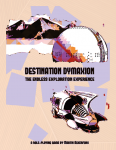Ackerfors
Alas, your rapids!
- Joined
- 21 Jan 2001
- Messages
- 7,499
Jag är lite osäker på vad jag håller på med och vad det i slutändan kommer att bli. Endera dagen är jag väldigt pepp, nästa tänker jag att jag borde lägga upp vrakdelarna här så att ni kan ta det som mot förmodan går att använda till något av era mycket bättre projekt.
Hur som helst, låt mig presentera …

Destination Dymaxion. The Endless Exploration Experience
Världen gick under, så som den oftast gör, och mänskligheten stängde in sig i stora kupoler, skyddade från den farliga och radioaktiva världen utanför. Livet var gott, inget fattades någon, egentligen, men det var också ganska trist.
En dag upptäckte forskarna att radioaktiviteten var borta och plötsligt var hela världen tillgänglig.
Rollpersonerna är de upptäckare som av rastlöshet eller äregirighet tar sitt fordon och drar ut på upptäcktsfärd.
Inspirationsmässigt befinner sig spelet i skärningspunkten mellan Wanderhome och Ultraviolet Grasslands, med en smula Svärdets sång och Vindsjäl bredvid. Dock finns två inspirationskällor som är mycket viktigare:
Först och främst är det arkitekten och uppfinnaren R. Buckminster Fuller. Han myntade begreppet Dymaxion (och här vet jag inte om jag är inne och travar på någon form av upphovsrätt) och ur hans, något speciella hjärna kom Dymaxion Car, Dymaxion House, Dymaxion Map, Dymaxion Sleep och Dymaxion Chronofile. Han var cool helt enkelt, och egen, och alla dessa delar vill jag ha med i spelet på olika sätt.
Bilen och huset är mest en fråga om estetik. Jag vill att känslan ska vara en blandning av 1950-tal och 1980-90-tal. Det känns som att det går att kombinera okej.
Vad som är viktigare för spelet är kartan. Hans kartprojektion syftade till att bibehålla proportionerna så långt det går. Det är svårt att projicera en sfär på något annat än en sfär, men … tjugosidig, det är ju ganska nära. Världen i Destination Dymaxion är planeten Dymaxion vilken man triangelkrälar på med hjälp av en T20. Jag vill ha mycket världsgenerering, men det är också svårt att få till, och det är oftast när det gäller listor och tabeller moralen falnar.
Hur som helst, tanken är att man far runt i sin bil, upptäcker världen, hittar spännande platser, ser om det finns någon annan kvar i världen överhuvuvdtaget.
Den andra inspirationskällan är, lite oväntat, Pokemon-tv-serierna. Hur!? frågar i princip alla. Jo, jag såg att i deras berättelser är rivaliteten ganska viktig. Det gäller att bli bäst, men inte till varje pris. Det ska vara ärligt och kampen i sig är lika viktig som vinsten. Efter en pokemon-strid berömmer de varandra, tackar för god match och önskar lycka till till nästa gång man möts. Ofta är det också någon man känt länge eller har ett nära band till på annat vis.
Den typen av rivalitet vill jag få till som en drivande del i Destination Dymaxion. Att vara hack i häl på, eller jagas av rivalerna är en bit av spänningen. Det gäller att vinna över dem, retas med dem och samarbeta med dem om faran är för stor.
Jag vill, i den andan, att grundinställningen ska vara icke-våld och har därför helt struntat i stridsregler.
Oh well, reglerna då? Ganska simpelt, T20 med modifikationer över svårighetsgrad. Levels (tror jag, har inte bestämt mig). Rollpersonerna är väl utformade som playbooks. Varje expedition måste ha en ledare och sedan en ur tre olika grupper (sökare, fixare, vårdare), bara om man är fler än fyra spelare får man välja fler ur en grupp. För varje rollperson finns en rival så att rivalgruppen blir lika stor som spelgruppen, men det är spelgruppen som utformar rivalerna också.
Så var står jag nu?
Jag har skrivit ungefär 15 000 ord på spelet och jag vet inte om det är mycket eller lite, men reglerna är en stomme som jag är ganska nöjd med. Nästa steg är att skriva färdigt alla rollpersoner och lista färdigheter och sådant, samt att göra tabeller för resande, incidenter och världsgenerering. Den svåra biten antar jag. Innan den supersvåra med layout, bilder och eventuell distribution av det ska till.
Jag vet helt enkelt inte om det kommer bli något av det, men det är kul att presentera någonting i alla fall.



Hur som helst, låt mig presentera …

Destination Dymaxion. The Endless Exploration Experience
Världen gick under, så som den oftast gör, och mänskligheten stängde in sig i stora kupoler, skyddade från den farliga och radioaktiva världen utanför. Livet var gott, inget fattades någon, egentligen, men det var också ganska trist.
En dag upptäckte forskarna att radioaktiviteten var borta och plötsligt var hela världen tillgänglig.
Rollpersonerna är de upptäckare som av rastlöshet eller äregirighet tar sitt fordon och drar ut på upptäcktsfärd.
Inspirationsmässigt befinner sig spelet i skärningspunkten mellan Wanderhome och Ultraviolet Grasslands, med en smula Svärdets sång och Vindsjäl bredvid. Dock finns två inspirationskällor som är mycket viktigare:
Först och främst är det arkitekten och uppfinnaren R. Buckminster Fuller. Han myntade begreppet Dymaxion (och här vet jag inte om jag är inne och travar på någon form av upphovsrätt) och ur hans, något speciella hjärna kom Dymaxion Car, Dymaxion House, Dymaxion Map, Dymaxion Sleep och Dymaxion Chronofile. Han var cool helt enkelt, och egen, och alla dessa delar vill jag ha med i spelet på olika sätt.
Bilen och huset är mest en fråga om estetik. Jag vill att känslan ska vara en blandning av 1950-tal och 1980-90-tal. Det känns som att det går att kombinera okej.
Vad som är viktigare för spelet är kartan. Hans kartprojektion syftade till att bibehålla proportionerna så långt det går. Det är svårt att projicera en sfär på något annat än en sfär, men … tjugosidig, det är ju ganska nära. Världen i Destination Dymaxion är planeten Dymaxion vilken man triangelkrälar på med hjälp av en T20. Jag vill ha mycket världsgenerering, men det är också svårt att få till, och det är oftast när det gäller listor och tabeller moralen falnar.
Hur som helst, tanken är att man far runt i sin bil, upptäcker världen, hittar spännande platser, ser om det finns någon annan kvar i världen överhuvuvdtaget.
Den andra inspirationskällan är, lite oväntat, Pokemon-tv-serierna. Hur!? frågar i princip alla. Jo, jag såg att i deras berättelser är rivaliteten ganska viktig. Det gäller att bli bäst, men inte till varje pris. Det ska vara ärligt och kampen i sig är lika viktig som vinsten. Efter en pokemon-strid berömmer de varandra, tackar för god match och önskar lycka till till nästa gång man möts. Ofta är det också någon man känt länge eller har ett nära band till på annat vis.
Den typen av rivalitet vill jag få till som en drivande del i Destination Dymaxion. Att vara hack i häl på, eller jagas av rivalerna är en bit av spänningen. Det gäller att vinna över dem, retas med dem och samarbeta med dem om faran är för stor.
Jag vill, i den andan, att grundinställningen ska vara icke-våld och har därför helt struntat i stridsregler.
Oh well, reglerna då? Ganska simpelt, T20 med modifikationer över svårighetsgrad. Levels (tror jag, har inte bestämt mig). Rollpersonerna är väl utformade som playbooks. Varje expedition måste ha en ledare och sedan en ur tre olika grupper (sökare, fixare, vårdare), bara om man är fler än fyra spelare får man välja fler ur en grupp. För varje rollperson finns en rival så att rivalgruppen blir lika stor som spelgruppen, men det är spelgruppen som utformar rivalerna också.
Så var står jag nu?
Jag har skrivit ungefär 15 000 ord på spelet och jag vet inte om det är mycket eller lite, men reglerna är en stomme som jag är ganska nöjd med. Nästa steg är att skriva färdigt alla rollpersoner och lista färdigheter och sådant, samt att göra tabeller för resande, incidenter och världsgenerering. Den svåra biten antar jag. Innan den supersvåra med layout, bilder och eventuell distribution av det ska till.
Jag vet helt enkelt inte om det kommer bli något av det, men det är kul att presentera någonting i alla fall.



Last edited:


